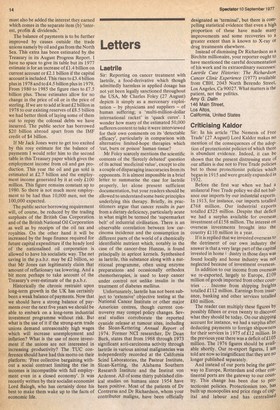Laetrile
Sir: Reporting on cancer treatment with laetrile, a food-derivative which though admittedly harmless in applied dosage has not yet been legally sanctioned throughout the USA, Mr Charles Foley (27 August) depicts it simply as a mercenary exploitation — by physicians and suppliers — of human suffering; a 'multi-million-dollar international racket' in 'quack cures'. I wonder how many of the estimated 50,000 sufferers content to take it were interviewed for their own comments on its 'detectable efficacy', particularly in comparison with alternative limited-hope therapies which 'cut, burn or poison' human tissue?
Mr Foley scarcely mentions the scientific contents of the 'fiercely debated' question of its actual 'medicinal value', except to cite a couple of disparaging inaccuracies from its opponents. It is almost impossible in a brief letter to summarise the case for laetrile properly, let alone present sufficient documentation, but your readers should be allowed to understand some basic principles underlying this therapy. Briefly, its practitioners argue that cancer results in part from a dietary deficiency, particularly acute in what might be termed the 'supermarket belt' of industrial civilisation. There is an observable correlation between low carcinoma incidence and the consumption in different parts of the world of a chemically identifiable nutrient which, notably in the case of the cancer-free Hunzas, is found principally in apricot kernels. Synthesised as laetrile, this substance along with a nutritional programme, often using enzyme preparations and occasionally orthodox chemotherapies, is used to keep cancer under control not unlike insulin in the treatment of diabetes mellitus.
Unfortunately, laetrile has not been subject to 'extensive' objective testing at the National Cancer Institute or other major American centres, though current controversy may compel policy changes. Several studies corroborate the reported cyanide releaseat tumour sites, including the Sloan-Kettering Annual Report of 1974. Former NCI researcher, Dr Dean Burk, states that from 1968 through 1973 significant anti-carcinoma activity through laetrile in various animal malignancies was independently recorded at the California Scind Laboratories, the Pasteur Institute, Sloan-Ketting, the Alabama Southern Research Institute and the Institut von Ardenne. All of some thirty published clinical studies on humans since 1954 have been positive. Most of the patients of Dr Contreras and Dr Richardson, whom your contributor maligns, have been officially designated as 'terminal', but there is compelling statistical evidence that even a high proportion of these have made many improvements and some recoveries to a greater extent than is known to X-ray or drug treatments elsewhere.
Instead of dismissing Dr Richardson as a Birchite millionaire, your reporter ought to have mentioned the careful documentation of his work and its extraordinary successes: Laetrile Case Histories: The Richardson Cancer Clinic Experience (1977) available from CBH, 2043 North Berendo Street, Los Angeles, Ca 90027. What matters is the patient, not the politics.
Amy G. Da/In 146 Main Street, Los Altos, California, United States






























 Previous page
Previous page